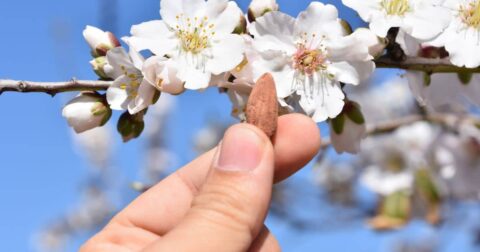Explainer
How Overconsumption Affects the Environment and Health, Explained
Climate•12 min read
Explainer
Almond milk has become increasingly popular over the last decade or so. More and more Americans enjoy it in recipes or their coffee, or even straight from the carton. Yet many consumers want to know — is almond milk bad for the environment? After all, it comes from thirsty…


Words by Björn Ólafsson
Almond milk has become increasingly popular over the last decade or so. More and more Americans enjoy it in recipes or their coffee, or even straight from the carton.
Yet many consumers want to know — is almond milk bad for the environment? After all, it comes from thirsty trees, some farmed during long periods of drought in California. Here we take a look at just how much water goes into making almond milk as compared to dairy, and other plant-based options.
Almond milk is a drink made from blended and strained almonds mixed with water and some other potential flavoring ingredients like sugar or vanilla, depending on the type of milk.
Despite the dairy industry’s pushback against plant-based products sold using the word “milk,” “milk” has long been used to describe the resulting drink. Not only has almond milk been popping up in cookbooks since at least the 13th century, but the Oxford English Dictionary includes plant-based milks in its definition. The FDA recently ruled that almond milk is, in fact, a milk.
Overall, almond milk is not that harmful for the planet, especially when compared to cow’s milk. There are some areas of concern that consumers should be aware of, however.
One of the worst aspects of almond farming is its water usage. Compared to other plants, almonds are thirsty, needing about 371 liters of fresh water per liter of milk. That’s more than soy milk, oat milk and even rice milk, but still significantly less than dairy milk.
Unfortunately, nearly 80 percent of the almonds grown worldwide come from California, an area especially vulnerable to drought. Almond production is a contributing factor to droughts in the state, although its water footprint is lower than dairy. California farmers are also shifting to more efficient irrigation techniques, which save water when compared to practices used 10 or 20 years ago.
Almonds have a big pesticide problem, with over 34 million pounds of active ingredients spread on almond trees in the U.S. in 2017, more than most other crops. Increased pesticide use can be harmful to agricultural workers and to local wildlife populations, especially insects.
All of these pesticides can have a negative impact on bees in particular. Some honeybee farmers consider avoiding almond trees for fear of the damage that pesticides can do to their bee colonies.
Yet there is room for improvement. Many groves of almond trees are increasing biodiversity by planting other forms of flora, hoping to sustain local bees and pollinators.
On almost every metric, milk from cows is more environmentally damaging than milk from almonds. In fact, every single type of plant-based milk is a more sustainable choice than the milk from cows.
Dairy milk requires 8.95 square meters of land per liter, while almond milk only requires half a square meter. Animal agriculture is an inherently inefficient use of land thanks to the amount of feed required by animals, with beef farming alone responsible for 41 percent of deforestation worldwide. Dairy production is no exception to the trend.
Dairy milk emits 3.15 kilograms of greenhouse gases per liter, while almond milk only emits 0.7 kilograms, more than four times less. Cows are ruminant animals, which means that they are huge emitters of methane when kept in the vast numbers required for the beef and dairy industries.
Though almond milk is heavily criticized for its water use, dairy milk requires more water than almond milk. One liter of dairy milk requires a whopping 628 liters of fresh water, compared to the 371 liters for almond milk — still high but not nearly as bad.
In the American West, the biggest water guzzlers are feed crops like corn and alfalfa, which are fed to farmed animals like dairy cows. Animal agriculture places huge demands on water supply during a drought. While almonds contribute to this problem, they are still less of a burden than dairy, but more than other plant-based milks.
Dairy milk also causes more pollution as excess nutrients are washed into waterways with potentially harmful consequences for aquatic life. Animal agriculture is also responsible for its own significant pesticide use for growing feed crops.
In most U.S. supermarkets you can find aisles brimming with milk options, from cow’s milk to various plant-based milks. Each one requires different levels of water and land usage, and is responsible for a different quantity of emissions.
Per liter, oat milk production uses:
Takeaway: oat milk is much less harmful to the environment than dairy or almond milk.
Per liter, soy milk production uses:
Takeaway: soy milk is one of the best milks in terms of environmental impact, and fortified soy milk offers the same nutrients as dairy milk, which is also fortified.
Since cashew milk is less common than other plant-based milks, its life cycle assessments have yet to be explicitly analyzed by scientists. However, production of cashews themselves uses:
If we assume 130 grams of cashews per liter of milk, as many online recipes use, this equates to about:
Cashew milk is also sometimes made with poor labor practices. And since cashews can only be grown in certain climates, the carbon emissions from transportation bump up their total (although food production is always more of a factor in emissions than transportation).
Takeaway: more research is needed.
Per kilogram, coconut milk production uses:
Coconut milk is sometimes linked to deforestation in Southeast Asian countries to grow the coconut trees necessary for production. Also, because collecting the coconuts is physically difficult, workers’ rights are sometimes abused during the harvesting process. That’s why it is important to buy fair trade or local coconuts.
Takeaway: Check origin labels as coconut milk can be linked to deforestation.
Picking one milk that is most environmentally friendly is difficult, but soy and oat milks have low impacts almost across the board — land, water and emissions. It’s also clear that dairy milk is the worst choice — more destructive in nearly every way than plant-based milks.
The good news is that the sustainable choice can also be a healthy one, particularly if you opt for an unsweetened and fortified choice like soy. If you choose to drink almond milk, look for almond milk produced with a Bee Better seal to ensure that minimal pesticides were used in production. The big takeaway is it’s clear plant-based milks are better for the planet, and can be part of a healthy diet too.